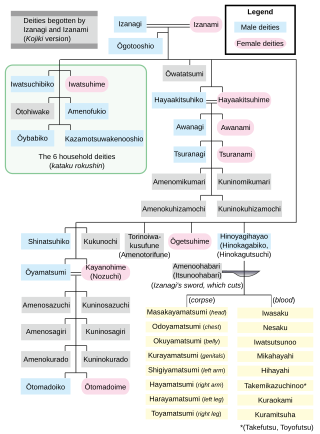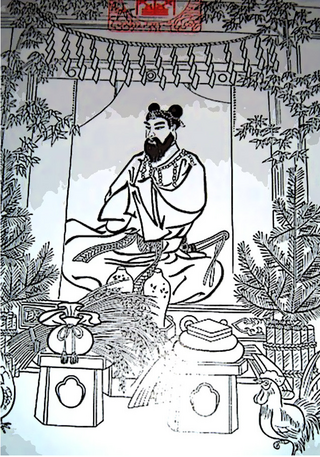Family tree
- Pink is female.
- Blue is male.
- Grey means other or unknown.
- Clans, families, people groups are in green.
| Nunakawahime | |
|---|---|
| Major cult centre | Amatsu Shrine, Kota Shrine |
| Genealogy | |
| Spouse | Ōkuninushi |
| Children | Kinomata (Kimata), Shitateruhime , Ajisukitakahikone, Kotoshironushi, [1] Takeminakata and others |
Nunakawahime is a Shinto goddess. [2]
She is worshipped in Shinto, known particularly for her association with 'sound' and 'ringing'. She helps people sing. [2]
She is the mother of Takeminakata. [3] and Kotoshironushi. [4]
Nunakawahime is especially sought after by expectant mothers, as she is believed to grant easy childbirth and blessings of children. [2]
Nunakawahime is a character in the Kojiki, an ancient Japanese text. She is not mentioned in the Nihon Shoki. In the Kojiki, there is a story about Ōkuninushi. He went to Koshi No Kuni to propose to Nunakawahime. He stood outside her house and recited a poem. He wanted to marry her. Nunakawahime was hesitant at first. But the next day, she accepted with a poem. They got married. [2]
Nunakawahime is not often mentioned in historical texts. But she is known for her love of poetry and her calm nature. She helps women in important times like childbirth. Many women look up to her for support and advice.. [2]
For those involved in professions or hobbies related to poetry or song, it is customary to honor Nunakawahime, as it is believed that doing so brings joy to the goddess. [2]

Ōyama-tsumi or Ohoyama-tsumi, also Ōyama-tsumi-mi'oya-no-mikoto (大山祇御祖命), is a god of mountains, sea, and war in Japanese mythology. He is an elder brother of Amaterasu and Susanoo. His other names are Watashi-no-Ōkami (和多志大神) and Sakatoke (酒解神).
Kagutsuchi, also known as Hi-no-Kagutsuchi or Homusubi among other names, is the kami of fire in classical Japanese mythology.

Ukanomitama is a kami in classical Japanese mythology, associated with food and agriculture, often identified with Inari, the deity of rice.

Toshigami, also known as Ōtoshi-no-kami, is a Japanese kami and a part of the Shinto pantheon.
Okami in the Kojiki, or in the Nihon Shoki: Kuraokami (闇龗) or Okami (龗), is a legendary Japanese dragon and Shinto deity of rain and snow. In Japanese mythology, the sibling progenitors Izanagi and Izanami gave birth to the islands and gods of Japan. After Izanami died from burns during the childbirth of the fire deity Kagu-tsuchi, Izanagi was enraged and killed his son. Kagutsuchi's blood or body, according to differing versions of the legend, created several other deities, including Kuraokami.

Kamo Clan Infomation.
Kotoshironushi (事代主神), also known as Yae Kotoshironushi no kami (八重言代主神), is a Shinto kami.
Kamimusubi (神産巣日), also known as Kamimusuhi among other variants, is a kami and god of creation in Japanese mythology. They are a hitorigami, and the third of the first three kami to come into existence (Kotoamatsukami), alongside Ame-no-Minakanushi and Takamimusubi, forming a trio at the beginning of all creation. The name is composed of kami, denoting deity, and musubi, meaning "effecting force of creation".
Tamakushi-hime also known as Mishimanomizokui-hime and Seyadatarahime (セヤダタラヒメ), is a feminine deity who appears in Japanese mythology. She is known as the mother of Himetataraisuzu-hime, the first empress of Japan, Kamo no Okimi, a distant ancestor of the Miwa clan, Kamigamo the deity of Kamigamo Shrine. She is also known as Princess Mishima-Mizo, Seiyadatarahihime, Katsutamayori-biyorihime and Kimikahihime.
Kamotaketsunumi no Mikoto (賀茂建角身命) is a god in Japanese mythology.

Susa Shrine is a Shinto shrine in Izumo, Shimane, Japan. It is the 18th Shinto shrine in the Enza-no-kai Organization list of shrines and temples considered important to the historical region of Izumo, which includes other major shrines in Shimane and Tottori Prefectures including Izumo-taisha, Kumano-taisha, and Ōgamiyama Jinja.

Ashinazuchi and Tenazuchi are a pair of Japanese deities. They are the parents of Kushinadahime, the wife of Susanoo-no-Mikoto. The serpent killed their other 7 daughters.
Kamo no Okimi was the son of Kotoshironushi and Tamakushi-hime, and brother of Himetataraisuzu-hime. He was an ancestor of the Kamo clan, and by extension through Ōtataneko (太田田根子) the Miwa clan.
Kamuō Ichihime is a Japanese goddess. She is a daughter of Ōyamatsumi.

Oyamakui no Kami (大山咋神) is a Japanese god highly significant in Sannō Ichijitsu Shintō, and worshipped in the Hiyoshi Taisha network of shrines and the Matsunoo Taisha network. They are also known as Sanno Gongen in a Buddhist context. They are the son of Toshigami and grandson of Susanoo. Oyamakui no Kami is considered to be androgynous and possibly hermaphroditic. They are the kami of mountains and good health.
Ō clan is a descendant clan of Jimmu and Himetataraisuzu-hime. They are descended from Kamuyaimimi.
Yashimajinumi (八島士奴美神) is a Japanese god.
Konohanachiru-hime is a Japanese goddess.
Omizunu was a Japanese deity. the Great Great Grandson of Susanoo-no-Mikoto.
Ame-no-Fuyukinu is the son of Omizunu and Futemimi, the husband of Sashikuni Wakahime and the father of Ōkuninushi(Ōnamuchi).